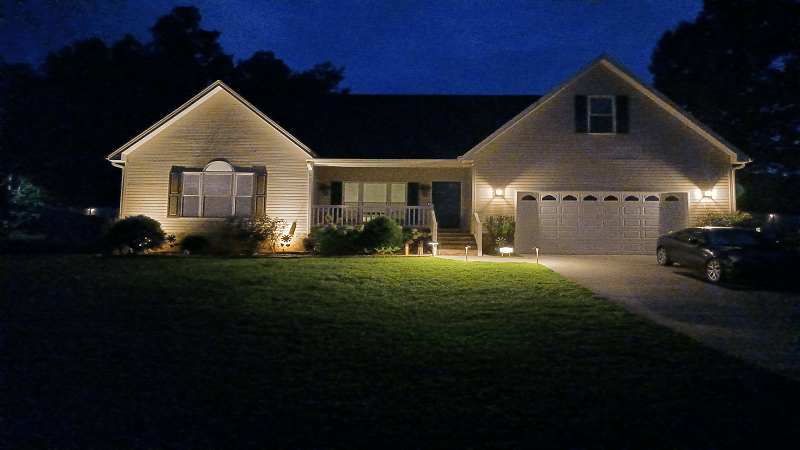Every year, as the days grow shorter and temperatures drop, something magical happens in neighborhoods everywhere. Homes come alive with twinkling lights, casting a glow that signals warmth, togetherness, and celebration. Beyond the sparkle and color, there’s a deep psychological connection between lighting and emotion. Outdoor lighting doesn’t just decorate a home it sets the stage for memories. The colors, brightness, and design choices can shape how families feel and how traditions are remembered for years to come. This post explores the psychology behind outdoor holiday lighting, how it influences mood and nostalgia, and why the simple act of illuminating your home can bring joy to entire communities.
The Emotional Power of Light
Light has always been tied to human emotion. Throughout history, people have used light to represent hope, renewal, and connection. During the holidays, lighting takes on an even deeper meaning it brightens the darkest nights of winter and reflects our collective desire for warmth and comfort. From the soft glow of string lights to the bold brilliance of LED displays, outdoor lighting has the power to change how we feel the moment we step outside. It can energize, calm, inspire, or comfort depending on how it’s used. Psychologists explain that our brains associate light with positive emotions like joy, safety, and nostalgia, which makes it a powerful tool during the holiday season.
Color Temperature and Mood
One of the most fascinating aspects of lighting psychology is how color temperature influences mood. Warm lights such as the golden hue of traditional incandescent bulbs tend to evoke feelings of coziness, nostalgia, and relaxation. These are the tones that remind people of candlelight dinners, fireside gatherings, and cherished childhood holidays. On the other hand, cooler tones like white or blue LED lights can create a crisp, modern look that feels refreshing and vibrant. They often give off a feeling of excitement and clarity, which can make a display feel energetic and alive. The best holiday lighting designs often blend both tones, creating balance and harmony that appeals to a wide range of emotions.
Lighting Placement and the Power of Space
Beyond color, where lights are placed has a big psychological effect. Lighting the roofline or outlining windows, for example, can make a home appear more welcoming and complete. Pathway lights invite guests in, while tree lights draw the eye upward, symbolizing aspiration and hope. Well-placed lighting can make a small yard feel expansive or turn a quiet street into a festive destination. People instinctively respond to these cues our brains are wired to interpret illuminated spaces as safe, social, and inviting. A thoughtful lighting layout can turn an ordinary house into a holiday landmark that captures attention and lifts spirits.
How Families Use Lighting to Build Memories
Holiday lighting goes beyond design; it’s about connection. Families who decorate together create more than a beautiful home they build shared experiences that become part of their traditions. Children remember the sound of the ladder being set up, the smell of the cold air, and the moment the lights first flicker on. Parents remember the laughter, the teamwork, and the joy of seeing their home glow. These experiences become annual rituals that tie generations together, creating emotional anchors that last a lifetime. For many families, professional holiday light installation in St. Peters, Missouri has become a way to bring that magic to life safely and beautifully while focusing on enjoying the moments that matter most.
Nostalgia and the Glow of Memory
There’s a reason why holiday lights can instantly take us back in time. Psychologists describe nostalgia as a positive emotional experience that helps people connect the past with the present. The soft glow of lights can trigger sensory memories like watching snow fall outside the window or walking through a decorated neighborhood as a child. These emotional associations make lighting more than decoration; it becomes a bridge to cherished moments. This is why so many adults feel a sense of calm and joy when they see traditional lighting displays it reconnects them to feelings of innocence, love, and belonging.
Brightness and Energy: Finding the Right Balance
Brightness is another element that plays a role in the psychology of lighting. Too much intensity can feel overwhelming, while dim lights can appear dull or lifeless. The best displays strike a balance, using varied brightness levels to create depth and interest. Soft white lights can highlight architectural details, while brighter elements like wreaths, roof outlines, or driveway arches draw attention to focal points. When balanced correctly, lighting feels harmonious and emotionally uplifting, encouraging people to linger and enjoy the scene rather than simply pass by.
Neighborhood Joy and Shared Experiences
Outdoor lighting has a ripple effect that goes beyond individual homes. When one family decorates, it often inspires others to join in, creating a sense of collective celebration. Entire neighborhoods can transform into radiant displays of community pride. This shared participation strengthens social bonds and fosters a sense of belonging. Walking or driving through these brightly lit streets becomes a shared tradition, a way for families and neighbors to connect through joy. For children, these experiences form vivid holiday memories that define what the season feels like bright, warm, and full of togetherness.
Turning Décor into a Sensory Experience
Modern Christmas light installations have evolved from simple strings of bulbs to immersive sensory experiences. Professional designers understand how different lighting elements interact with human perception. The gentle twinkle of lights, the contrast of colors, and the rhythm of patterns can evoke emotion in powerful ways. For many families, lighting isn’t just visual—it’s something they feel. The glow reflects off snow, music fills the air, and the entire environment transforms. When done thoughtfully, holiday lighting engages multiple senses at once, creating an atmosphere that feels magical and emotionally rich.
Tradition Meets Innovation
Technology has changed how people express holiday spirit through lighting. From energy-efficient LEDs to smart lighting systems that sync with music, innovation allows homeowners to personalize displays like never before. Yet the emotional core remains the same. Whether it’s a simple string of warm lights or a fully animated show, the goal is connection. Lighting reminds us that joy is meant to be shared, and that even small acts like illuminating a porch can brighten someone’s day. Families who embrace both tradition and technology often find new ways to express creativity while keeping the familiar warmth of the holidays alive.
The Science Behind the Warm Glow
Studies in environmental psychology show that lighting directly affects serotonin levels and overall mood. Warm, soft light can reduce stress and promote feelings of happiness and security. During the holidays, this effect is amplified by emotional context people associate these lights with love, generosity, and hope. This explains why neighborhoods filled with lights feel uplifting and why even simple displays can boost community morale. In many ways, outdoor lighting is a visual language of comfort that everyone understands, regardless of age or background.
Creating Joy, One Light at a Time
Every strand of light contributes to something bigger. Lighting design is both art and psychology, blending aesthetics with emotion. Whether you prefer classic white lights or colorful displays, what matters most is the feeling they create. Thoughtful lighting can make a home feel more welcoming, help families bond through shared traditions, and spread joy throughout the community. It’s not just about what people see it’s about how it makes them feel.
FAQs
- Why does holiday lighting have such a strong emotional effect?
Holiday lighting triggers emotional responses because it combines light, color, and memory. Our brains associate warm light with comfort and nostalgia, making us feel connected to past joyful experiences and loved ones. - What colors are best for creating a cozy, nostalgic holiday feel?
Warm tones like soft white, amber, and gold tend to evoke feelings of warmth and comfort. They’re perfect for traditional displays that bring a sense of calm and familiarity. - How can lighting encourage community interaction?
When multiple homes decorate, it creates a shared sense of celebration. Neighbors often take walks or drives to enjoy the lights together, building stronger connections and community pride. - Why do professional installations make such a difference?
Professional installers understand how to balance brightness, color, and placement for maximum visual and emotional impact. They also handle safety and maintenance, allowing families to enjoy the experience without stress.
Conclusion
Holiday lighting is more than a seasonal decoration it’s an emotional language that brings people together. The glow of outdoor lights can calm, energize, and connect us to memories that define who we are. Through thoughtful design, color choices, and placement, lighting can turn an ordinary home into a beacon of warmth and joy. Whether done by hand or through expert holiday light installation in St. Peters, Missouri, the goal remains the same: to create light that not only shines on the outside but also touches hearts on the inside.

